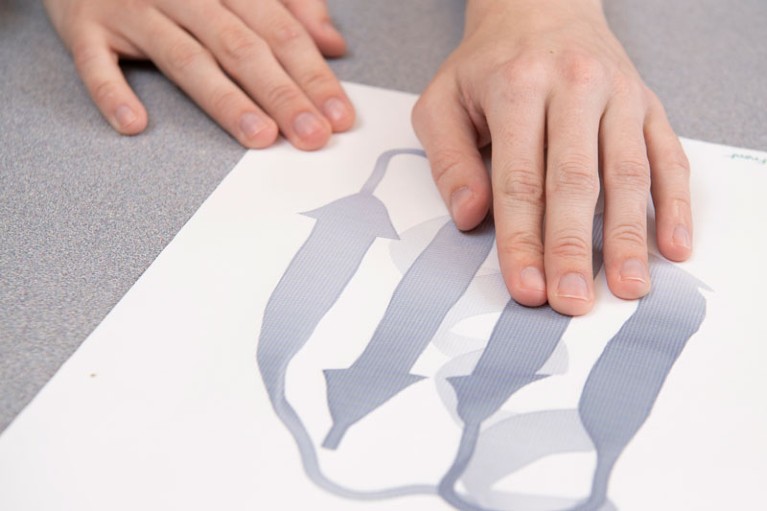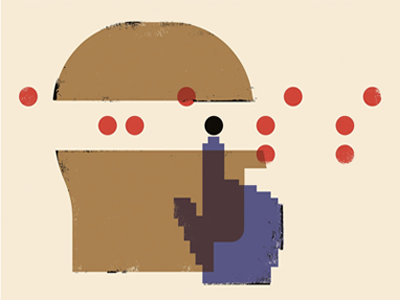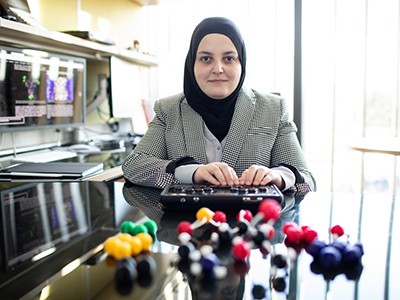Structural biology is an inherently visible science. By inspecting the 3D buildings of biomolecules, researchers achieve perception into their features and decide how they work. As a sighted particular person, J.H.-P. didn’t give this truth a lot thought — till a blind pupil joined her workforce.
O.S., who has been blind since start, enrolled to do a chemistry diploma on the College of Delaware in Newark in late 2019. She was fascinated by the thought of conducting computational chemistry analysis, however was uncertain of the method and the potential challenges that the work would current with regard to accessibility. Absolutely working with hazardous chemical substances, fragile glassware and complex tools would pose substantial obstacles for her and her information canine, Ripple. Then, a Analysis Experiences for Undergraduates programme for chemists with disabilities supplied O.S. the chance to have interaction in analysis in an surroundings that was aware of her talents and desires. The programme’s coordinators related O.S. with J.H.-P., whose computational structural-biology tasks provided a substitute for benchwork.
J.H.-P., then in her first yr as a school member on the college, welcomed the problem of approaching her analysis from a brand new perspective. With O.S., she enlisted C.Y., an assistive-technology specialist and assistant director of incapacity assist providers on campus. Motivated by the conviction that college students with disabilities ought to have equal entry to science, C.Y. was excited to collaborate with them.
These instruments assist visually impaired scientists learn information and journals
We got down to develop a analysis programme that might give O.S. an expertise to match that of her friends who aren’t blind. What adopted was an thrilling interval of exploration and improvement that resulted in a publication, a poster at a nationwide convention and a toolkit to assist different researchers with low imaginative and prescient to work together in a area that they may not have realized was open to them.
Right here’s the way it occurred.
Science-speak
Our first step was to research the assistive expertise O.S. was already utilizing, which included display readers and refreshable Braille shows. Display screen readers are applications that use synthesized speech to convey the data on a pc display, permitting customers to entry digital content material by listening, Braille shows use an array of mechanical pins that rise and decrease to kind Braille characters, enabling customers to learn textual content proven on a display by way of contact. As soon as correctly configured to function in a scientific computing surroundings — as an illustration, to work on the Linux working system — these instruments facilitated many sensible features of O.S.’s analysis.
Computational analysis is usually achieved utilizing a text-based interface generally known as the command line. Researchers can use the command line to subject directions to the pc, create and edit textual content information, write code and submit computing duties for processing. By changing the textual content that she entered and acquired from the pc terminal into audio, O.S.’s display reader gave her full entry to this textual interface. Given that almost all high-performance software program in computational chemistry, biophysics and structural biology embrace a text-only mode, she may obtain and manipulate the atomic coordinates of biomolecular buildings, put together the information wanted to simulate their movement, run these simulations and analyse the outcomes.

Raised photos (generally known as tactile graphics) which can be created on particular sort of paper are a great tool for analysing 3D buildings of proteins.Credit score: Kathy F. Atkinson/College of Delaware
Often, command-line info would seem in a format that was complicated when learn aloud by the display reader, akin to tables. In these circumstances, J.H.-P. wrote code to routinely convert the data right into a extra linear format, as an illustration by reworking tabular information into quick sentences.
The Emacs textual content editor, which could be managed utilizing keyboard quick cuts or textual instructions, together with the speech and audio interface, Emacspeak, allowed O.S. to shortly navigate and work together with the contents of textual content information. The Braille show was helpful for coding and scanning by way of textual content in information or on the command line, notably when the display reader’s voice was unclear. Easy plots may very well be interpreted by way of sonification software program, which transforms information into sounds, offering an auditory reasonably than visible type of evaluation.
However what in regards to the biomolecular buildings? O.S. nonetheless wanted a approach to discover the advanced 3D structure of biomolecules that didn’t rely upon sight. 3D-printed fashions have been an apparent resolution and proved helpful for conceptualizing protein folds and secondary buildings. But, these fashions took hours to provide, and have been restricted within the quantity of structural element they contained. In addition they couldn’t convey the movement predicted by biomolecular simulations.
Chemical modelling with a way of contact
To guage various methods, we relied on C.Y.’s experience in tactile graphics. Tactile graphics are raised photos projecting from a flat background, that are produced by embossing or utilizing a kind of paper that swells with the appliance of warmth, such that printed footage stand up off of the web page. Collectively, O.S. and J.H.-P. wrote a plug-in (referred to as TactViz) for the extensively used Visible Molecular Dynamics (VMD) software program to depict proteins as cartoon diagrams, shaded by distance from the viewer. Such shading leads to tactile graphics during which the spatial proximity of structural options to the viewer correlates with the elevation of the picture, that means that areas of the protein that seem nearer to the viewer swell larger off the web page. O.S. was in a position to discern secondary and tertiary protein buildings from these graphics, which have been fast and cheap to generate. We discovered that tactile graphics additionally supplied a good way to create accessible plots, particularly in circumstances during which the variety of information factors overwhelmed the sonification software program.
Tactile dynamics
After all, printed photos can’t be rotated and manipulated as on-screen buildings can, limiting O.S.’s potential to totally look at advanced biomolecules. Nevertheless, we have been then launched to the Graphiti, a multi-line refreshable tactile show manufactured (and generously loaned to us) by Orbit Analysis in Wilmington, Delaware. When related to O.S.’s pc, the Graphiti show acted as a monitor that was accessible by contact reasonably than sight, mirroring photos on the display with an array of mechanical pins, the heights of which adjusted routinely in response to adjustments in brightness. Our TactViz protein representations, already optimized for tactile graphics, displayed clearly on Graphiti, lastly offering O.S. with interactive entry to her biomolecular buildings and, to some extent, their simulated movement.

Olivia Shaw’s three-year-old information canine, Ripple.Credit score: Kathy F. Atkinson/College of Delaware
Combining these assistive applied sciences with software program instruments that she developed to print text-based descriptions of the structural options of proteins and their spatial relationships, O.S. was lastly positioned to conduct analysis on an analogous stage as her friends who aren’t blind. In a single yr, O.S. had collected information utilizing a nationwide supercomputer, submitted an accessible poster on her mission to the American Chemical Society nationwide assembly in 2020 (which was held just about) and submitted a manuscript1 to the Journal of Science Training for College students with Disabilities.
Having lived her life in a world that was not designed together with her circumstances in thoughts, O.S. was no stranger to devising workarounds to realize her objectives. Such flexibility and flexibility are important expertise for any researcher, and these qualities propelled her success within the lab. Additionally essential to our collaboration was J.H.-P.’s and C.Y.’s responsiveness to O.S.’s said wants, reasonably than their assumptions.
By means of respectful communication, persistence and outside-the-box considering, we leveraged our mixed experience to develop tractable options for inclusivity which have impression past the expertise of a single pupil. The neighborhood of blind and partially sighted individuals represents an untapped expertise pool in science, expertise, engineering and arithmetic (STEM) fields, however instruments designed with accessibility in thoughts may help researchers throughout a number of disciplines, no matter visible acuity or limitations. We hope that by sharing our expertise, we are able to encourage others to take part in coaching researchers who’re blind or have low imaginative and prescient, in addition to to contemplate their distinctive talents and desires when growing applied sciences.



